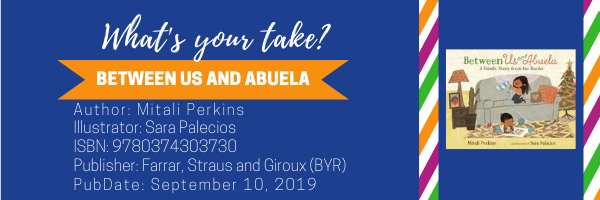By Michele Ebersole, University of Hawaii, Hilo, HI, and Yoo Kyung Sung, University of New Mexico, Albuquerque, NM

This month, Michele and Yoo Kyung give their takes on rethinking cultural and physical borders in children’s literature to understand today’s global politics through history. They begin their series with Between Us and Abuela: A Family Story from the Border by Mitali Perkins and Sara Palecios.

MICHELE: I thoroughly enjoyed reading this story. The illustrations are pleasing and inviting for the reader. The written text is told straightforwardly and simply yet raises a complex issue while offering a genuine child-friendly solution.
The practice of giving gifts during a holiday season to a grandparent resonates with children universally. The difference in this story is that the grandchildren are on the U.S. side of the border and Abuela is on the Mexican side of the border and there are fences that keep them separated. Giving gifts in this particular setting becomes a challenge; especially for the young children who don’t understand the need for fences to separate people. They simply want to give their gifts to their grandmother. Young Maria is aware that her younger brother Juan’s card might not be able to fit through the fence and is disappointed to learn that she has to mail her grandmother the scarf she knitted when the border officers inform her “Sorry, we can’t let anything through the fence.” However, when Juan finds out that his homemade card can’t be given to Abuela through the fence, he is inconsolable, and Maria is determined to find a way to get his card to Abuela. She finds an innovative solution to helping her brother achieve his wish.
There are many powerful underlying messages in this simple story. The young character Maria uses creative thinking to find an innovative method for solving a problem. It shows us how we can push back or find ways around some of the rules and policies that may not make sense. It shows how we can challenge ourselves to find ways to meet our intended goals. I believe that this story sends the message that it is ok to do so when it doesn’t hurt or harm anyone. It shows that a child’s love and goodness can supersede border walls.
YOO KYUNG: The book cover and the first living room page illustrate Maria’s family image. It is interesting to observe they have no other family pictures but a framed picture of Abuela. The story signals it is family time with a Christmas tree and the holiday wall decoration at the living room windows. A mother and Maria’s baby brother seem to make a happy family. Maria’s father figure is not available at her home space or her bus trip to Border Field State Park in San Diego. The wired border fence is endlessly standing through the ocean too. Until the end of the story that Juan’s gift flies to Mexico’s side, not a single seagull flies on Mexico side but staying on the San Diego side or standing on the fence. I find what Seagull symbolizes in the illustrations interesting.
Although the story depicts how Maria’s entire family is happy to see each other while the border fence is standing in the middle of the entire family, it is somewhat unrealistic how the story focuses on happiness not sad emotion that they haven’t seen each other for 5 years and finally they are allowed to see with the border fence standing. Emotive depictions could have been a little more realistic than simply happy. They cannot even hug each other, but the characters seem satisfied with the way they are limited to see each other and extremely controlled how long they can see each other and also they cannot share any gift. Although this story seems to convey a special family reunion during the holiday season, it mirrors so much of prison formality, meeting over a fence while 24-hour surveillance. I wish the story depicted sad reactions in this family reunion, especially as Maria’s mother and her Abuela haven’t met for years until now. It is good that Maria has a strong agency to do something when she wasn’t allowed to do anything for Abuela. I am grateful to learn about Las Posada and La Posada Sin Fronteras through this picturebook. The book sends an invitation to raise awareness of the enforcement zone between the primary and secondary border walls under the surveillance of Border Patrol officials.
Title: Between Us and Abuela: A Family Story from the Border
Author: Mitali Perkins
Illustrator: Sara Palecios
ISBN: 9780374303730
Publisher: Farrar, Straus and Giroux (BYR)
PubDate: September 10, 2019
Throughout August 2020, Michele and Yoo Kyung give their take on books for young people to rethink cultural and physical borders. Check back each Wednesday to follow the conversation!
- Themes: Between Us and Abuela, Michele Ebersole, Mitali Perkins, Sara Palecios, Yoo Kyung Sung
- Descriptors: Books & Resources, My Take/Your Take
